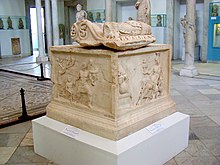Altar of the Gens Augusta

The Altar of Gens Augusta is a Roman altar dedicated to the imperial cult , which was discovered on the slope of Byrsa Hill above the port of the ancient city of Carthage . It is now in the Bardo National Museum in Tunis .
Historical context
The altar was found in close proximity to the temple of Gens Augusta. Like many other public buildings, the temple belonged to the Roman quarter of Carthage, which was built after the Roman colonization in 29 BC. Was created according to plan.
The Punic city of Carthage, in 146 BC. Destroyed by the Romans towards the end of the Third Punic War , should already be 123 BC. To become a Roman colony according to the will of Gaius Sempronius Gracchus . However, the colonization was only tackled under Augustus, who was supported by a resolution by Julius Caesar from the year 46 BC. Chr. Preceded. The chosen name Colonia Iulia Concordia Carthago points on the one hand to Augustus' adoptive family, the Julier , and on the other hand to the Roman goddess of peace Concordia , who was the patroness of the city.
description
The altar is made of Carrara marble and is decorated with bas-reliefs on all four sides. The reliefs are framed by a kind of pilaster on which stems and either bay leaves or flowers are applied. On the first page there are five human figures and a cow that is to be prepared for a taurobolium (ritual sacrifice). The second page shows Aeneas' flight . He carries his father Anchises on his left arm , while Ascanius / Iulus , his son, is on his right hand . The Julier refer to the descent of Iulus. In Virgil's Aeneid furthermore describes how Aeneas after his flight from Troy , the founder of Carthage Dido visited. The two remaining pages show the personification of Rome in the form of an Amazon and Apollo with a kithara . The Roman god was closely related to Augustus.
- Relief pages
Flight of Aeneas
meaning
The altar, discovered in 1916, received praise from experts. Louis Poinssot published a monograph in 1929 that is still fundamental to the work of art to this day.
In the middle of the 20th century, Jean Charbonneaux classified the altar as a fine example of Roman folk art. He emphasized his “clarity and naive simplicity”, especially with the background that “only a few monumental reliefs from the time of Augustus have survived”.
Other experts confirm the importance of the altar. The Tunisian archaeologist Abdelmajid Ennabli sees it as an “important document for understanding the imperial ideology”. For Mohamed Yacoub it is a manifesto of Augustinian art, since it creates a connection “between Roman realism and Greek idealism”. Yann Le Bohec even regards it as "the most spectacular evidence of Roman art in Africa to date".
literature
- Louis Poinssot: L'autel de la Gens Augusta à Carthage , Direction des antiquités et des arts, Tunis / Paris 1929.
Web links
- Object entry for Altar of Gens Augusta in the Arachne archaeological database .
Individual evidence
- ^ Jean Charbonneaux: L'art au siècle d'Auguste . La Guilde du Livre, Lausanne 1948, pp. 75-77.
- ↑ Abdelmajid Ennabli, Georges Fradier, Jacques Pérez: retrouvée Carthage . Cérès / Herscher, Tunis / Paris 1995, ISBN 9973190556 , p. 40.
- ^ Mohamed Yacoub: Le musée du Bardo: Départements antiques . Agence nationale du patrimoine, Tunis 1993, p. 111.
- ^ Yann Le Bohec: Histoire de l'Afrique romaine . Picard, Paris 2005, ISBN 2708407511 , p. 56.




